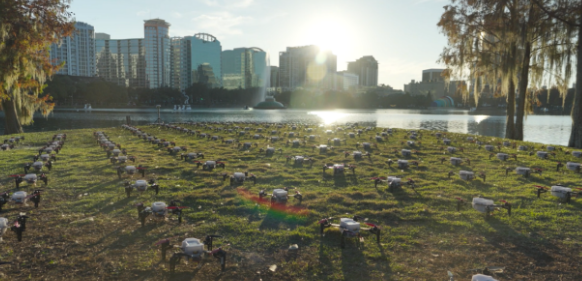On December 21, 2024, about 1830 eastern standard time (EST), multiple small unmanned aircraft (sUA), experienced a loss of control and rapid descent while performing at a sUA lightshow at Lake Eola, Orlando, Florida. The swarm of sUA, Uvify IFO, were operated by Sky Elements LLC, doing business as (dba) Sky Elements Drone Shows.
A minor child was impacted in the face and chest by a sUA and was seriously injured. A post accident inspection revealed that numerous sUA impacted the ground and sustained substantial damage. The sUA
light show was operating under the provisions of Title 14 Code of Federal Regulations Part 107 and a Certificate of Waiver and Authorization issued by the Federal Aviation Administration (FAA).
sUA Description
The Uvify IFO is a small swarm light show drone, with four propellers weighing about 2.18
pounds. Overall dimensions are about 10.8 inches in length x 10.8 inches in width x 4.9 inches
in height.
History of Flight
The remote pilot in command (RPIC) reported that the light show consisted of 500 sUA launched from a small peninsula in the northeast corner of Lake Eola. Setup for the day was standard and consisted of preflight checks, ensuring that the software programming matched and was updated on all show computers, and the layout of the 500-drone grid on the ground.
Initially, about 5 aircraft were not accepting the launch data. Standard troubleshooting of the Wi-Fi access points was implemented, and all 500 aircraft were located on the network about 5 minutes before showtime.
A soft reboot of the entire fleet was conducted to bring all aircraft to “show ready” mode. After the reboot, all systems showed green except for the systems on two aircraft; who were removed from the show. The operational aircraft were armed and the countdown sequence initiated. At liftoff it was noted that the aircraft “layers” did not lift uniformly. Further investigation revealed that the launch parameter file that contained the final flight paths had not been sent, and that the show center was not completely aligned.
Show video confirmed that the aircraft did not liftoff in uniform layers and as they illuminated and moved to their first frame of animation, they shifted position and altitude which resulted in a collision with other aircraft and a loss of control.
After the collisions occurred numerous aircraft could be seen falling from the sky and impacting the ground. One aircraft could be seen streaking towards the audience.
After the loss of control event, the RPIC reported that he closely monitored the remaining aircraft through visual observation and telemetry readings from the ground control station. He determined that, due to the steps involved in pausing the show, recovering airborne aircraft and the designated flight paths, that the safest course of action for the audience and aircraft was to let the show proceed. The remaining aircraft completed the show and landed without further incident.
The operator reported that a review of aircraft logs revealed that the show position was rotated by 7°. The 7° misalignment resulted in the geo hard fence being too close to the audience. In addition, the fence was set to 5 meters rather than the company’s standard of 1 meter. The combined errors resulted in a reduced safety area that was outside of the company’s standards.
Each sUA contained a secure digital (SD) card that recorded data for that aircraft. Of the effected aircraft, about 42 were recovered by the operator and their SD cards were sent to the NTSB’s Vehicle Recorder Laboratory in Washington, DC, for analysis. One aircraft was recovered by law enforcement personnel and sent to the NTSB. Five aircraft are believed to have impacted the lake and were not recovered.
The NTSB was notified of the event and an accident investigation was initiated. As part of the investigative process, the NTSB invited qualified parties to participate in the investigation.
These included the Federal Aviation Administration (FAA) and Sky Elements LLC.
The parties were formed into specialized investigative groups led by NTSB group chairs in the areas of operations, systems, and flight data recorders (FDR).
Safety Actions
Since the time of the accident Sky Elements proposed the following mitigations to the FAA to prevent future recurrence: allowance for additional time on site prior to showtime to reduce time pressures, established an on-call system that requires the chief pilot or a second in command to verify that all the necessary steps have been completed before showtime, and additional training will be provided to all RPICs.
The investigation continues.
Related
Discover more from sUAS News
Subscribe to get the latest posts sent to your email.


